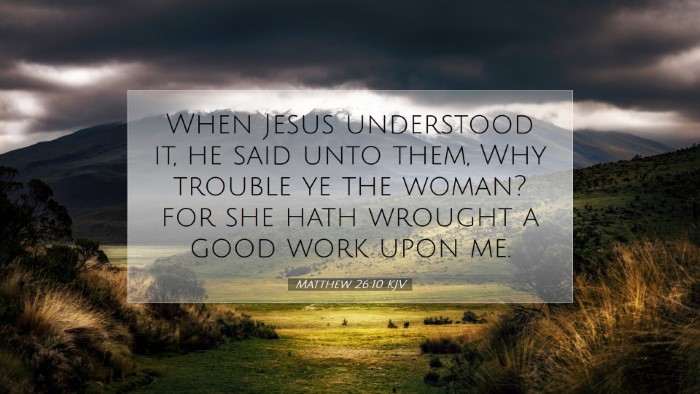Commentary on Matthew 26:10
Matthew 26:10 states: "When Jesus understood it, he said unto them, Why trouble ye the woman? for she hath wrought a good work upon me." This verse comes at a critical moment in the Gospel narrative, where Jesus is nearing the culmination of His earthly ministry. The passage brims with rich theological implications and character studies that demand careful examination.
Contextual Analysis
This event occurs shortly before the crucifixion and following the anointing at Bethany. In this context, it is essential to grasp the tension that surrounds Jesus as He faces imminent betrayal, trial, and death. The act of anointing becomes a profound expression of love and honor towards Christ.
Exegesis and Interpretation
-
Understanding the Incident:
As noted by Matthew Henry, the action of the woman who anointed Jesus is a model of devotion. Her act stands in stark contrast to the criticism she faces. The tension created by the disciples’ discontent serves to highlight the value of genuine worship.
-
Jesus’ Response:
Albert Barnes points out that Jesus' defense of the woman portrays His valiant love for the downtrodden and marginalized. His query, “Why trouble ye the woman?” reflects His protective nature. Scholars agree that this defense serves not only to vindicate her act but also to affirm the worth of sacrificial love and service.
-
Theological Significance:
Adam Clarke highlights that this verse teaches the principle of prioritizing what is spiritually valuable over material concerns. Jesus places intrinsic worth upon the woman's act, elevating its spiritual significance above societal norms that dictated utility. This challenge to societal norms invites deeper reflection on our own acts of worship and devotion.
Character Reflections
The contrasting responses in this passage—between the woman’s extravagant love for Jesus and the disciples’ critical views—provide a rich ground for character reflection.
-
The Woman:
Her actions represent profound humility and a willingness to give abundantly. Matthew Henry reflects that this is a demonstration of true faith that is undeterred by social convention or fear of public scorn. She acts purely out of love for the Lord, demonstrating the heart of a true worshipper.
-
The Disciples:
Their response reveals a potential pitfall in the Christian community—critique in the name of righteousness. Albert Barnes notes that they express concern for practicality and stewardship, potentially blinding them to the moment’s spiritual significance. This serves as a warning against valuing temporal utility over eternal devotion.
The Implications for Ministry
From a pastoral perspective, this passage calls for a reflection on our values and the motivations behind our worship and service. The question raised by Jesus echoes in our ministries: Are we more concerned with what seems practical than what glorifies God?
- Encouragement of Authentic Worship:
The narrative encourages ministers to foster environments where authentic worship is celebrated and encouraged—regardless of societal expectations or norms.
- Guarding Against Critical Spirits:
Ministry leaders must be vigilant against criticism that arises not from a place of discernment but from a lack of understanding. Adam Clarke emphasizes the need for a grace-infused approach that acknowledges others’ acts of devotion as legitimate expressions of faith.
- Valuing Sacrificial Love:
Finally, the passage serves as a reminder to value selfless acts of love and commitment to Christ, encouraging the community of believers to engage in loving acts for Christ’s sake.
Conclusion
In conclusion, Matthew 26:10 lays a profound foundation for understanding true worship and devotion. The diverse insights gleaned from public domain commentaries highlight the relational dynamics between Jesus, the anointing woman, and His disciples, illuminating the rich tapestry of faith, devotion, and opposition. This passage calls us to reflect upon our attitudes towards worship, encouraging us to prioritize authenticity and devotion in our spiritual lives. As we contemplate the richness of this encounter, may we aspire to reflect the same sacrificial love and devotion in our lives.


